League of Legends World Championship: With Finals Looming in San Francisco, Riot Games Goes All-in on REMI in Mexico City, NYC, Atlanta
Returning to in-person events, the team aims to capture the excitement of the onsite audience
Story Highlights
After two years without screaming fans in the stands, the League of Legends World Championship — the most-watched esports event on the planet — is back in full force this year with packed houses for its events throughout North America. After stages in Mexico City, New York City, and Atlanta over the past five weeks, Worlds will culminate with the highly anticipated Finals tomorrow at the Chase Center in San Francisco.
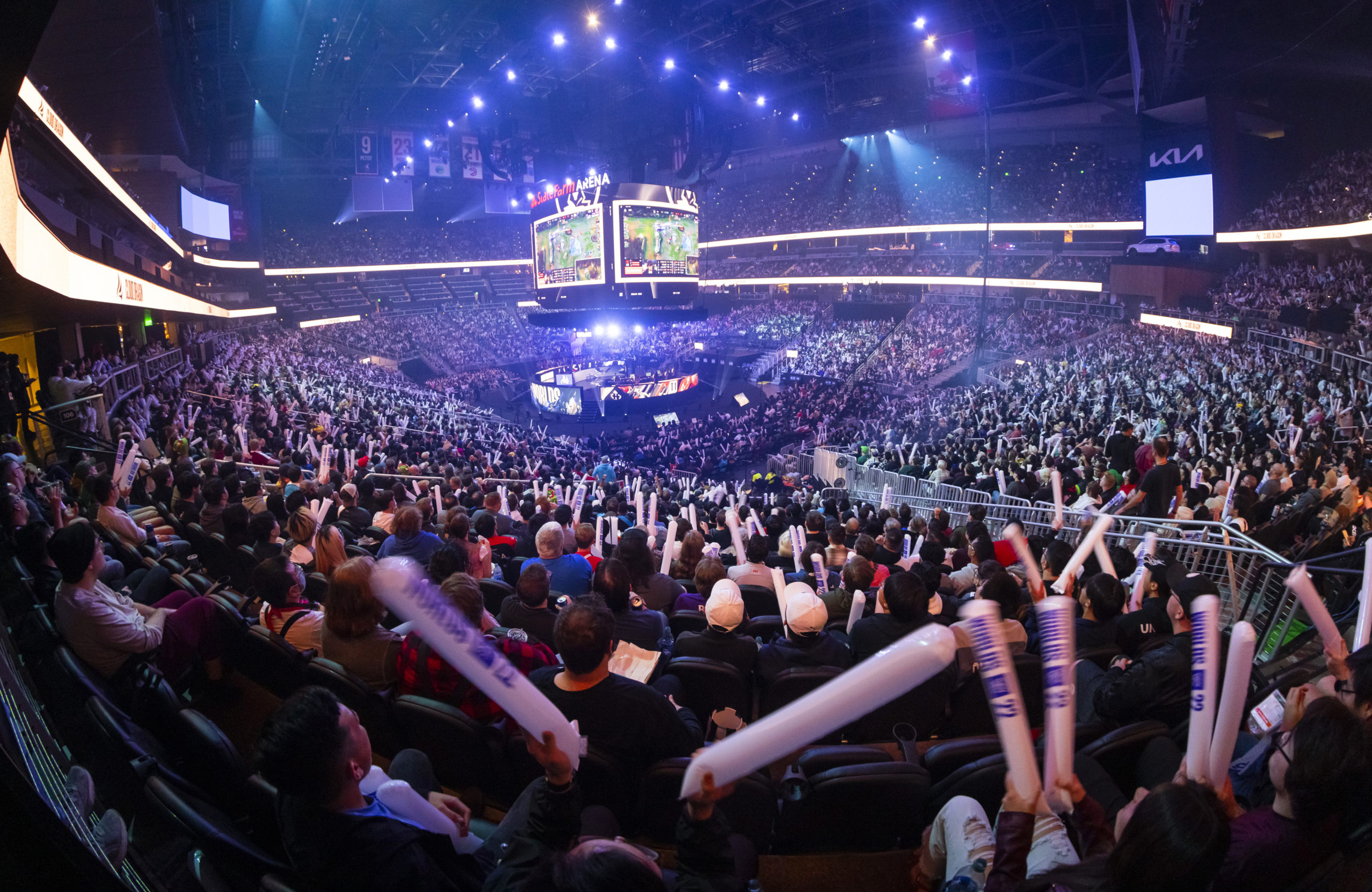
The atmosphere at the League of Legends World Championship Semifinals in Atlanta (Photo: Colin Young-Wolff/Riot Games)
“It’s night and day,” says Sam Chaimson, manager, live broadcast production, Riot Games. “Seeing fans cheering with signs, screaming, jumping up and down, and reacting makes for a totally different ballgame — both for fans [at the venue] and around the world. And it adds so much color, flavor, texture, and joy to our show. That joy, passion, and excitement reads on camera. That contagious energy comes through the lens, and it’s infectious for fans watching at home.”
To serve live productions in Mexico City, New York City, and Atlanta over the past five weeks, Riot Games is once again leaning on its tried-and-true REMI production model and leveraging its LCS (LoL Championship Series) Studio facility in Los Angeles. Riot Games was an early pioneer in the REMI realm. The pandemic drastically accelerated its remote-production efforts, and the fruits of its innovation in 2020 and 2021 are paying off at this year’s Worlds.
“We have been doing some form of REMI for a long time,” notes Michael Caal, technical broadcast manager, Riot Games. “It has always been on our roadmap, but the pandemic definitely fast-forwarded a lot of workflows that we had been holding off on. We had to get the production team accustomed to those workflows quickly because it all happened very fast. Once we started doing [in-person events] again, we had the confidence to know we can basically do the same types of workflows just with even better technologies.”
Traveling REMI Caravan: Mexico City to NYC to Atlanta to San Francisco
Riot’s global events team is responsible for producing a world feed that is made available to 22 broadcast partners (who create live feeds in 21 languages) for the Play-In stage in Mexico City (Arena Esports Stadium at Artz Pedregal), Group and Quarterfinal stages in NYC (Hulu Theater at MSG), Semifinals in Atlanta (State Farm Arena), and this weekend’s Finals at the Chase Center.
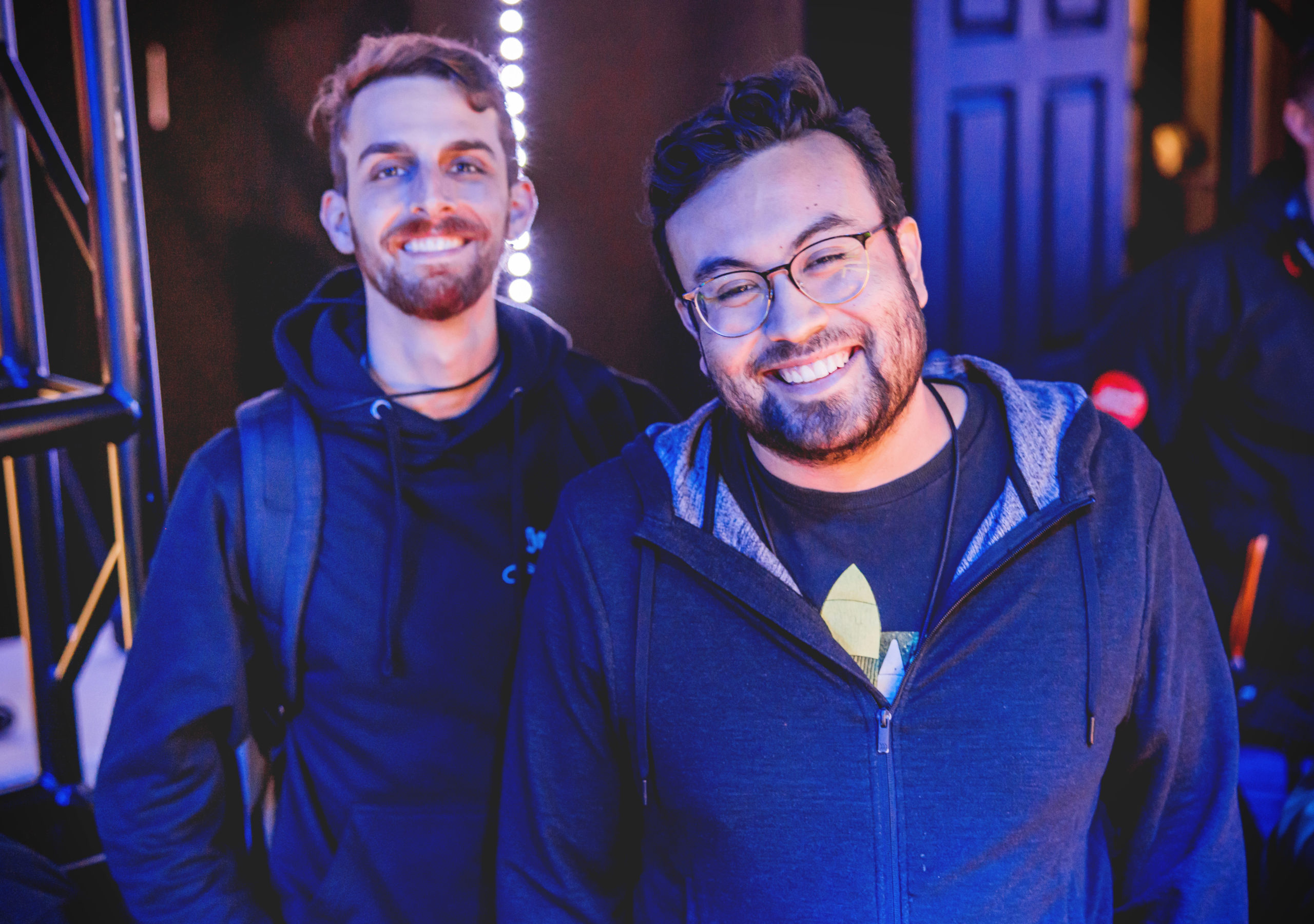
Riot Games’ Sam Chaimson (left) and Michael Caal onsite in NYC for the LoL Worlds Quarterfinals
Feeds from the venue are backhauled to the LCS Studio in Los Angeles via Riot Direct, the private network used for LoL gameplay around the globe. The world feed is produced out of the main control room in L.A. with only a small portion of the production team onsite at the venue. Chaimson, the lead director, and the assistant director are onsite, with the rest of the production crew — TD, A1, observers (in-game camera operators), and graphics and EVS replay operators — in L.A.
“We split it up so that we can get the best of both worlds,” says Chaimson. “Being [onsite] in person makes providing creative input so much easier in terms of blocking cameras and working with the stage managers. Thanks to the networking and transmission technology Riot has developed, the latency for comms and video when interfacing with our TD back in Los Angeles is pretty negligible. We’re able to cut a cool show that’s not compromised by the split.”
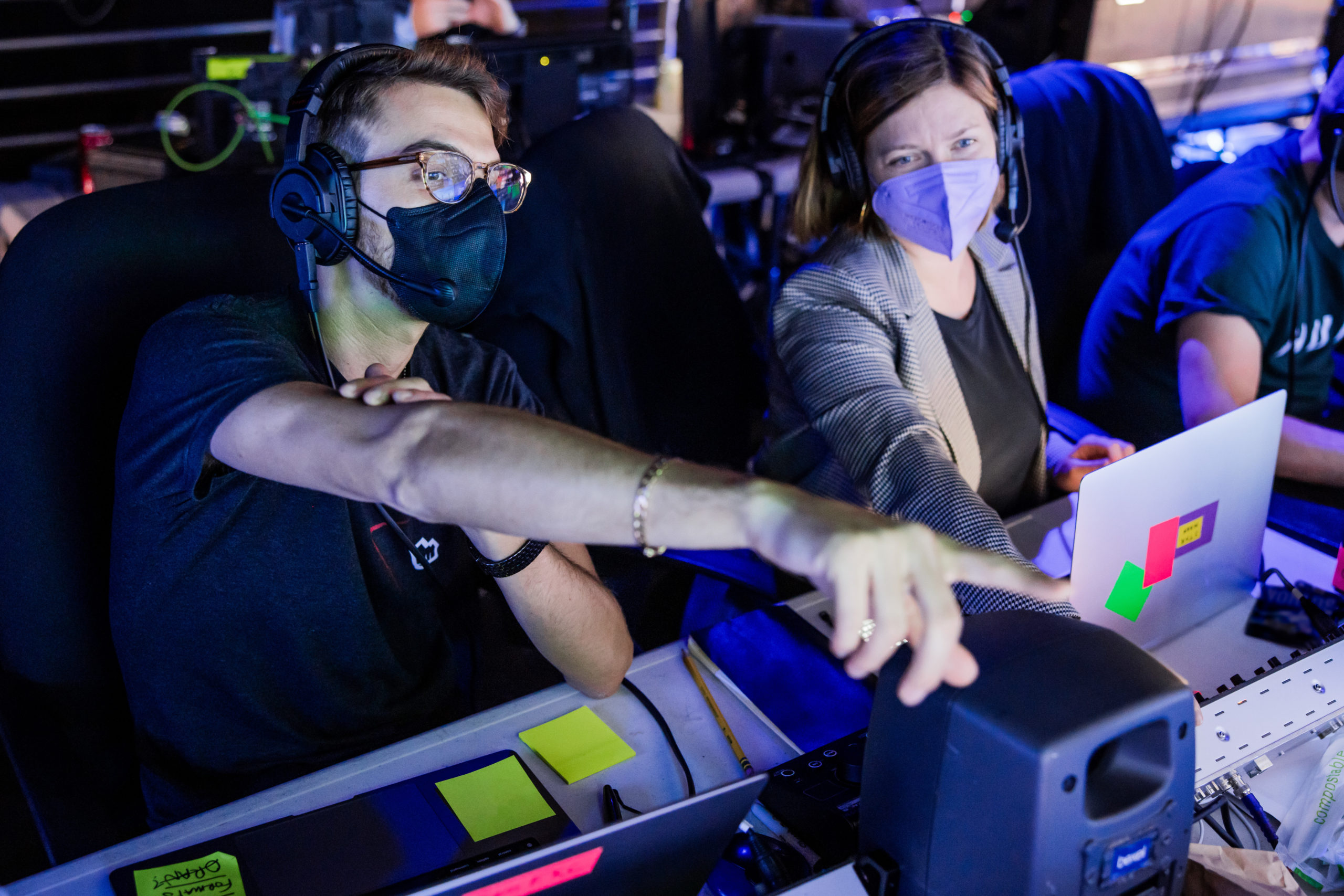
Sam Chaimson (left) is onsite along with the director and AD for LoL Worlds productions; the rest of the production team is in LA.
To accommodate the constant globetrotting required by Riot Games’ major events, the engineering team has built out a pair of identical transmission kits (TX1 and TX2) and a pair of MADI-based audio-routing kits that leapfrog one another from one event to the next along with a corresponding “Realm,” the private game server used exclusively for pro-level competitive LoL and other Riot Esports major global events and ensuring near zero-level latency.
“We built out the two transition racks at the beginning of the year],” says Caal, “and they have put on a lot of my mileage: Turkey, Copenhagen, Singapore, Korea, and now [North America]. Each consists of 40×16 Haivision SRT paths, and they also have the core network broadcast switches that we string out to all the locations around the venue.”
In addition to the bulk of the production team, the L.A. facility houses Riot’s global transmission operation, which distributes a clean version of the world feed to teams in Brazil, China, Korea, Turkey, and other regions to create their own world broadcast featuring commentary in their respective languages.
Feast for the Eyes: Creating the In-Venue Experience at Worlds
Anyone who has been to LoL Worlds events knows just how eye-popping the experience can be, with a cavalcade of striking visuals on the LED displays, impressive stage pieces, and electrifying lighting elements.
This year, Riot’s creative team once again partnered with POSSIBLE to develop custom LED content for each Worlds stage. Quince Imaging handles the processing for the live LED-board shows, and Ventuz graphics software drives the screen content.
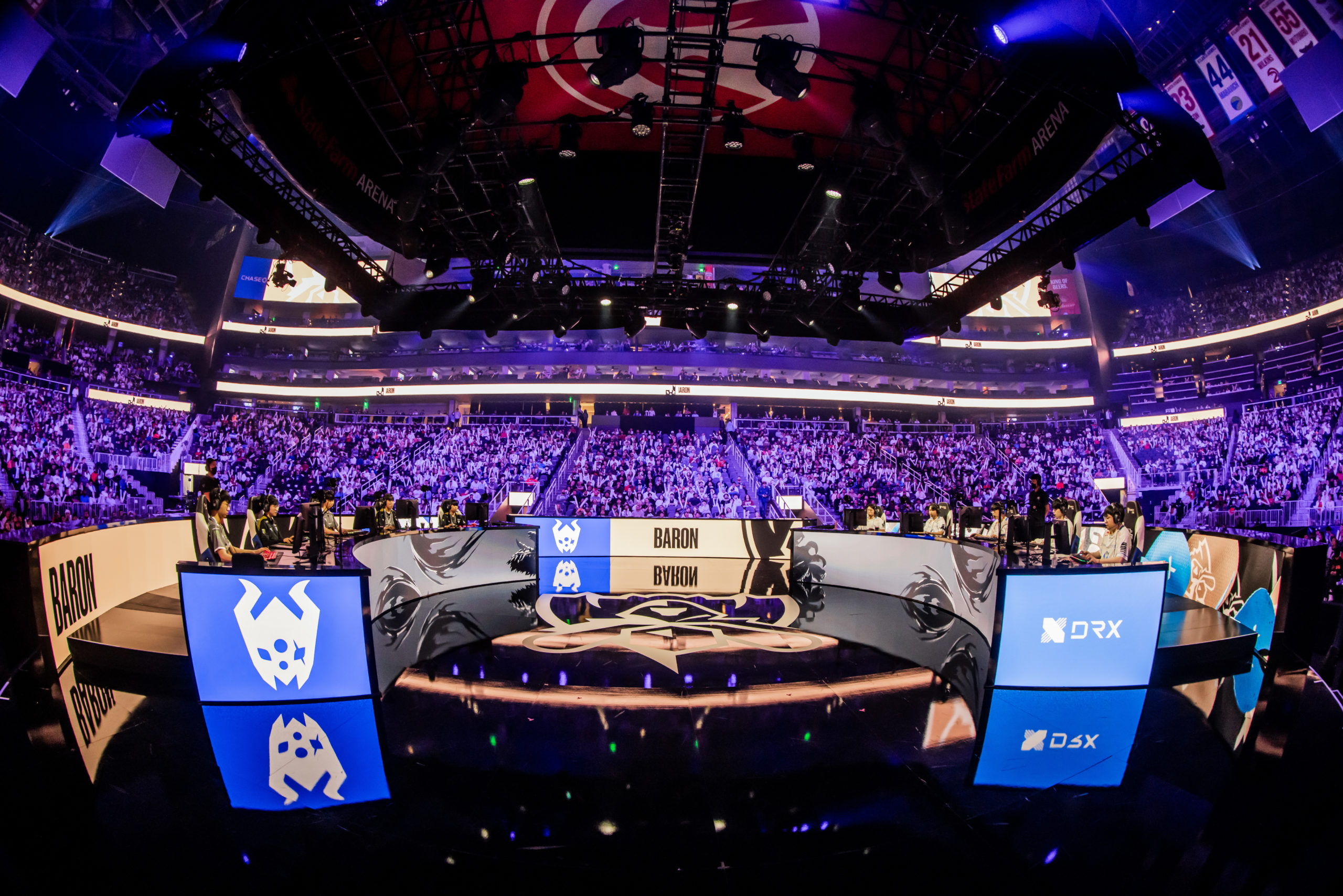
Teams Gen.G (left) and DRX compete at the League of Legends World Championship Semifinals in Atlanta. (Photo: Colin Young-Wolff/Riot Games)
“In order to tell the story of the tournament from stage to stage,” says Chaimson, “the visuals should evolve as the stakes get higher and the number of teams go down. We want a look that feels special for fans in the house and reads on broadcast as well. Regardless of which venue we are in, we want to create an experience where the set — as well as the fans and the [in-venue] environment – becomes part of the story.”
The LED displays and lighting system are tied into the LoL game’s live-stats API, which also drives the broadcast’s in-game graphics. With this integration in place, in-game events coming out of the Realm can automatically trigger in-venue on-screen and lighting elements in real time.
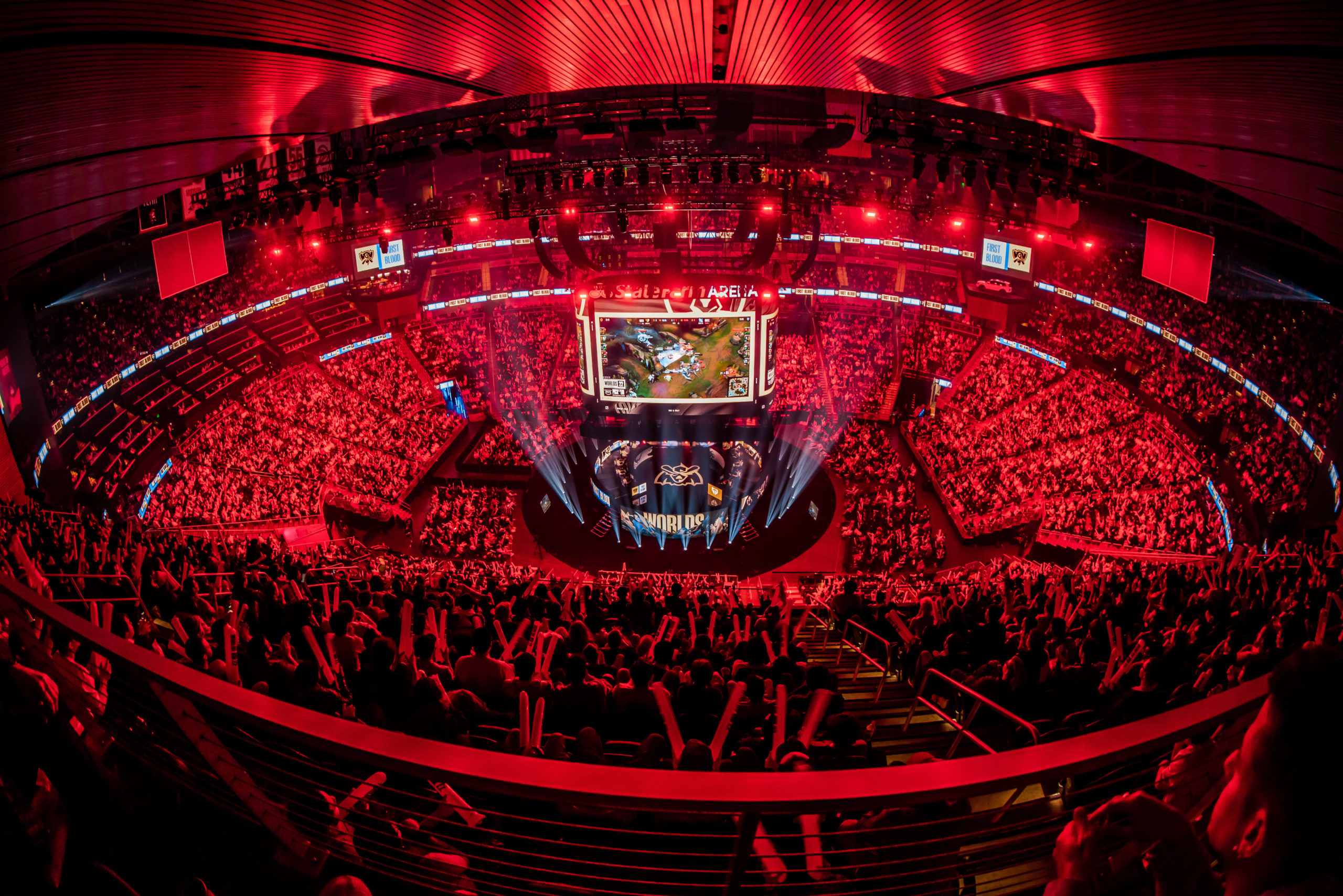
The League of Legends World Championship Semifinals packed the house at State Farm Arena in Atlanta. (Photo: Colin Young-Wolff/Riot Games)
“It’s our version of a home run or a grand slam,” says Chaimson. “Those big moments that happen in a split second can [automatically] trigger lights and screen content to elevate the experience for fans in the building. When those really exciting in-game moments happen, they can instantly be translated to something visually in-house that the fans can enjoy, and it makes the in-person experience even more special.”
In addition, as Riot continues to develop new features in the live-stats API, the production crew is able to develop new features in real time with Quince Imaging to create new elements within the show.
NEP Bexel also provides additional video- and audio-routing infrastructure onsite, along with a host of other gear for the live show. For Finals this weekend, NEP Atlas mobile unit will also be on hand at Chase Arena since the sprawling show requires additional infrastructure.
Cameras, Casters, Chronobreaks: Bringing the Onsite Experience to Fans Around the Globe
To deliver the raucous in-venue show to fans around the world, Riot has brought in a large camera complement for each stage of Worlds. The New York and Atlanta productions featured about two dozen front-of-house cameras (primarily Sony HDC-4300’s and Panasonic LUMIX BGH1’s for player POV cams) to cover the live competition along with additional PTZ cameras for behind-the-scenes coverage. As part of the complement in NYC and Atlanta, Riot rolled out a pair of wireless RF cameras (including a Steadicam rig with a Sony Venice cinema camera and Angenieux cinema lens) to cover both the stage and the crowd.
The Hulu Theater presented a particularly challenging setup given its smaller capacity and the wide proscenium stage. To eliminate the fewest seats possible, Riot leaned heavily on robos and POVs and also installed a trio of RailCams (featuring Sony HDC-P50 camera heads) in front of the stage for unique shots throughout the Group and Quarterfinal broadcasts.
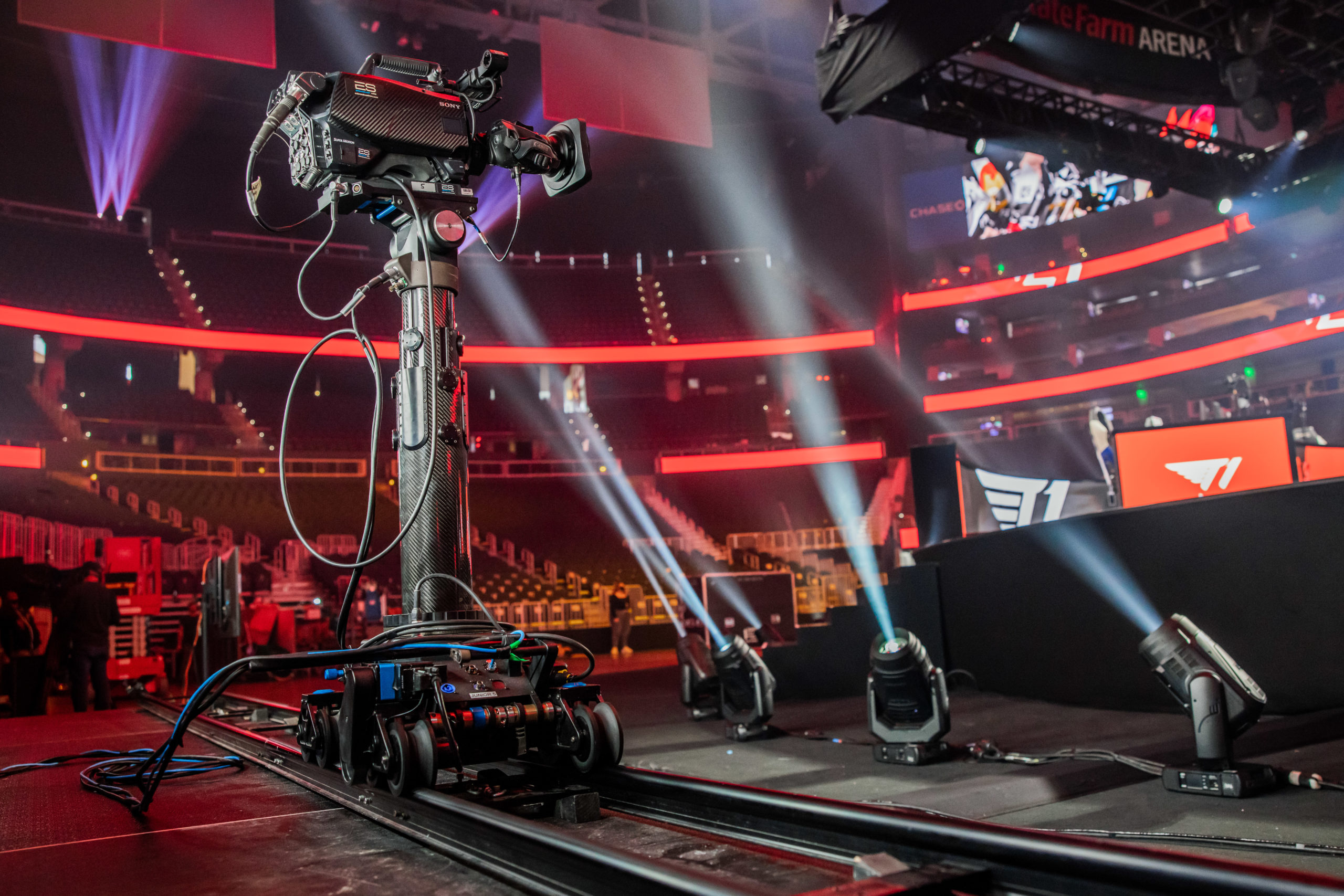
RailCams played a vital role in Riot’s coverage of the Quarterfinals and Semifinals at Worlds this year.
“Because of the [limited] capacity of the house,” Chaimson explains, “we wanted to offer as many seats to fans as possible, so killing a bunch of seats for a jib platform was not going to work. Instead, we were able to design a camera package that maximized our coverage while also maximizing seating for fans. We want to do our best to not only get the best camera coverage we can but also maintain the fan experience in the building.”
With a bigger venue and in-the-round setup at State Farm Arena in Atlanta, Riot added a TechnoCrane and more long lenses for front-of-house coverage during Semis (RailCam was also brought back). Although Riot’s English-language shoutcasters and analysts are on hand for all stages of Worlds, the Korean on-air team joined the party in Atlanta and will be onsite in San Francisco.
Riot also brings its full QC operation onsite for each stage of Worlds. This group serves as the league operations and tournament officials to ensure the highest level of competitive integrity. Its members monitor the network and player PCs (players in the venue and those forced into quarantine at a nearby hotel by COVID regulations).
“They can actually see what’s happening on the players’ PCs on stage,” says Chaimson. “In the event of a bug or a mis-click or another issue, they can triage similar to a challenge in football. They can decide to mitigate a bug in some way, or they can decide to trigger a Chronobreak, which is our tool to rewind the game in the event of some unforeseen circumstance that requires us to turn back time. These are the folks who make the call on the field to ensure that the competition is fair and the best players in the world are able to play on the best field of play in the world.”
Behind-the-Scenes Interviews: ‘Democratizing’ Coverage for Global Broadcast Partners
In addition to delivering the live competition feeds to broadcast partners around the world, Riot has also built a workflow for behind-the-scenes interviews (BSI) with players and coaches. Starting in 2020, when all esports events went online because of the pandemic, Riot developed a new system for broadcasters around the world to conduct real-time postgame interviews. Once in-person events returned, Riot opted to keep this workflow and enhance it for the hundreds of interviews conducted remotely during each stage.
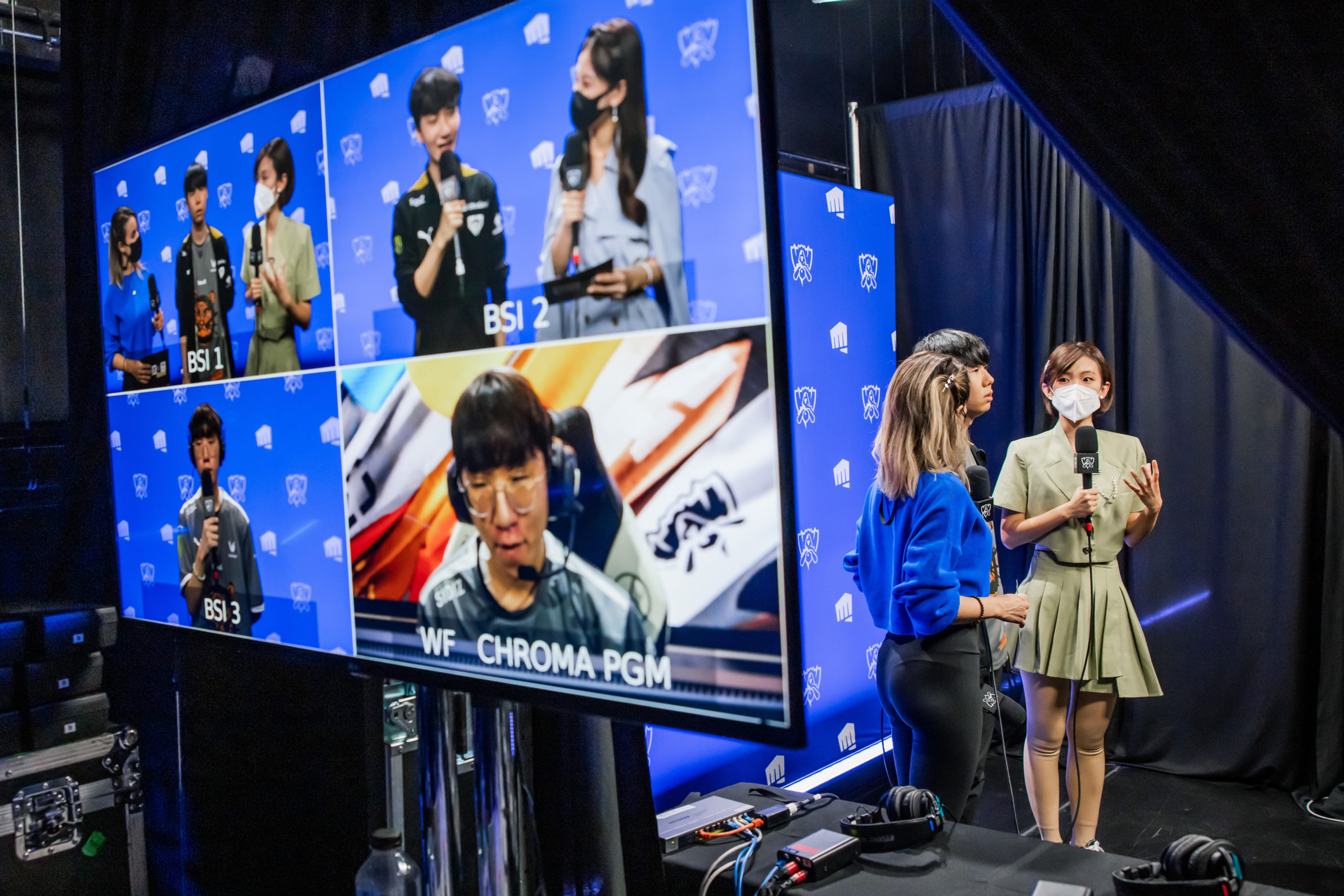
Behind-the-scenes interview booths allow broadcasters from around the world to conduct real-time interviews with players remotely.
“We use Zoom because that allows the interview to be as real-time as possible,” says Caal, “but we didn’t want just a low-fidelity Zoom call with a webcam. When a region wants an interview, the BSI producer will allow them to join a [Zoom] room matched with that specific BSI [booth backstage at the venue]. From there, we send three SRT feeds that are the same high quality as the world feed to connect them all together. We have the Zoom communications tied into the microphones and the headsets they are wearing. That way, they’re able to ask questions in real time, and the broadcast feed that everyone sees is the same SRT transmission that they would get with any other camera in the building.”
Chaimson adds, “We have a ton of broadcasters all over the world who aren’t able to be here in person but still want to participate. With this system, they can talk to players face-to-face and provide a first-class experience to their viewers without actually being here. It democratizes the coverage and raises the quality bar for everyone.”
World-Final Preview: Riot Once Again Ups the Ante for Opening Ceremony
Although details for the always extraordinary Opening Ceremony at the Worlds Final are still under wraps, Dot Esports reports that Riot has created its “most ambitious stage build ever” at the Chase Center.
Prior to the pandemic, Riot’s creative team found a way to somehow raise the bar with each year’s Opening Ceremony. After Lol’s Elder Dragon character was unleashed virtually via AR inside Beijing’s Bird’s Nest stadium in 2017, an AR version of the LoL in-game band K/DA performed virtually onstage alongside in-person performers in 2018. In 2019, the Opening Ceremony included hip-hop group True Damage performing next to holograms of their in-game counterparts.
The pandemic forced Riot to pivot to a closed environment for Worlds in 2020, but the company was able to create a no-less impressive extended-reality experience in Shanghai. And, after a last-minute COVID-related move to Reykjavík last year, Riot, instead of producing a live experience for the Opening Ceremony, opted to produce a 13-minute series of music videos blending real-world sets with the LoL-themed Arcane animated series.
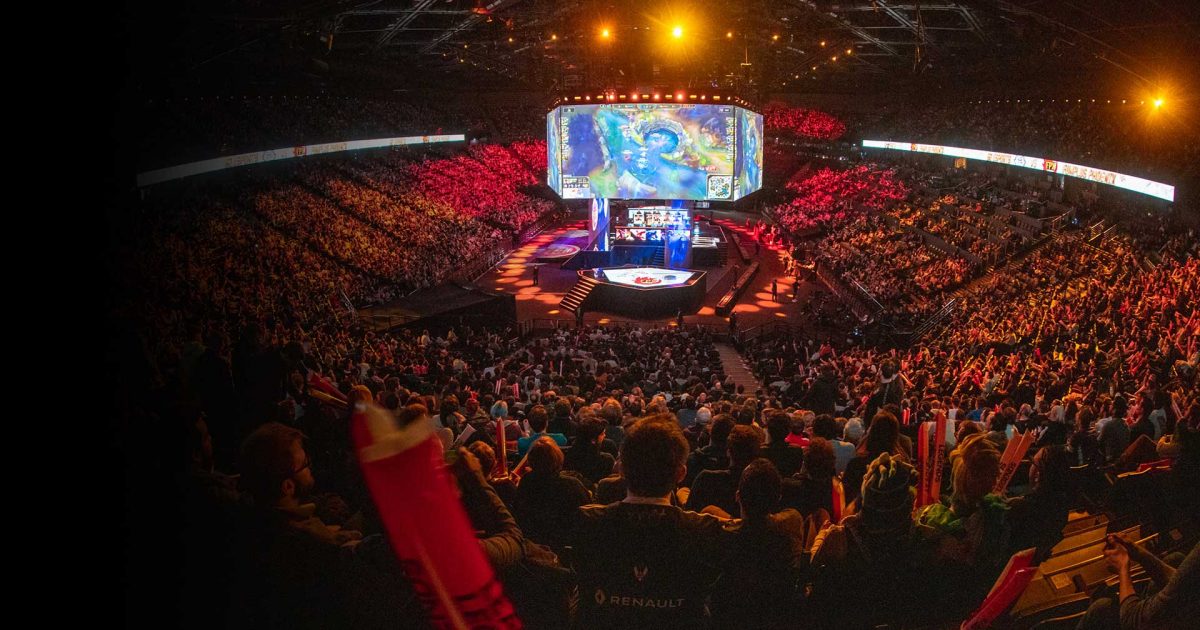
This year’s LoL Worlds final in San Francisco marks the return of fans for the first time since 2019, when the event was held in Paris.
With the Worlds Final Opening Ceremony finally back to full strength, tomorrow’s technology-fueled festivities will be headlined by a performance by Lil Nas X and promises to feature “quite a few surprising moments,” according to Dot Esports.
The Opening Ceremony broadcast will have a dedicated production team as well as plenty of extra resources and infrastructure. Between the Opening Ceremony and the Final competition itself, Riot will roll out a whopping 64 cameras. While the production of the final competition will be a REMI show out of L.A. like the other stages, NEP Atlas mobile unit will also be onsite to provide additional infrastructure.
“We consider Worlds to be in the upper echelons of sport, not just in esports,” says Chaimson. “That’s our Super Bowl, and we want it to be truly special for both fans in the building and the tens of millions of fans watching around the world. We’re pulling out all the stops and bringing in new toys. We’re being mindful throughout the tournament of how we can level up the experience so that, as the stakes rise, so does the production experience. And it all culminates in the Final. It’s the peak of competition, and we try to make it the peak of our capabilities as a broadcast and production team at Riot.”
The Opening Ceremony of the 2022 League of Legends World Finals will begin with initial coverage on Saturday, Nov. 5 at 8 p.m. ET. Stay tuned for more on coverage of the Finals on sportsvideo.org. If you are interested in learning more about Riot’s REMI efforts, register now for the SVG Esports Production Summit to see the Keynote Session: “Inside Riot Games’ Project Stryker and Its Mission To Change the Game in Global Remote Production for Esports and Beyond.”
